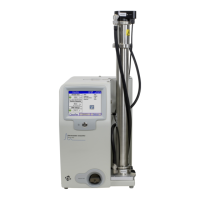Product Overview 1-9
The inlet to the Nano DMA is an axial 1/4-inch port. (Note: A 3/8-inch port
is offered and recommended if operating at aerosol flow rates above
4 L/min). The inlet to the 1nm-DMA is an axial 3/8-inch port. The aerosol
flows through a short connecting tube that quickly widens in a conical
section to reach a narrow annular channel. The inner cone is fixed by four
narrow supports at the top of the outer cylinder. This design promotes
axisymmetric aerosol flow and reduces distortions of the flow field. To
accommodate the axial aerosol inlet, the sheath air flow is routed through
the center electrode from the bottom before it is turned 180 degrees and
passed through a Dacron screen flow straightener (as in the Long DMA).
The 1nm-DMA and Nano DMA have an extra concentric cylinder below the
inlet slit that allows an increased polydisperse aerosol flow up to the inlet
slit. This increased flow reduces the particle transport time and therefore,
reduces diffusion losses up to the inlet slit. The extra inlet flow exits the
DMA as bypass flow. In addition, to match the velocity of sheath air and
aerosol flow, and to reduce electric field penetration into the slit, the slit gap
has been reduced to 0.26 in. [0.66 mm]. The extra flow passes through a
perforated ring to provide enough pressure drop to assure a uniform and
undisturbed aerosol flow at the inlet slit.
To improve the flow field at the sample slit (in the center electrode), the exit
design for the 1nm-DMA and Nano DMA include four thin supports instead
of twelve holes for the Long DMA. The lower section of the center
electrode also contains concentric cylinders. The inner cylinder allows the
sheath air to pass up to the top of the DMA while the outer cylinder carries
the monodisperse sample flow from the exit slit to the exit port.
The central electrode of the Nano DMA has an outer radius of 0.369 in
(0.937 cm) and a grounded electrode with an inner radius of 0.75 in (1.905
cm). The characteristic length has been shortened to 1.963 in (4.987 cm)
to reduce the effects of diffusion.
The characteristic length of the 1nm-DMA has been further shortened to
0.787 in (2 cm). As in the Nano DMA, the central electrode of the
1nm-DMA has an outer radius of 0.369 in (0.937 cm) and the grounded
electrode has an inner radius of 0.75 in (1.905 cm).
Note: The characteristic length is the distance between the middle of the
inlet slit and the middle of the outlet slit.
Bypass Flow
Some applications of the Model 3085A Nano DMA and 3086 1nm-DMA
use the bypass flow option to bring aerosol to the inlet slit faster than the
maximum flow rate of the detector (CPC or electrometer) in order to
minimize ultrafine particle losses caused by diffusion. This is especially
important when using the 1nm-DMA with particles <3 nm. Bypass flow is
not provided by the 3082 Classifier, but can be pulled or exhausted from
the 3085 or 3086 through the Bypass Flow port. The Bypass Flow port is
shipped with an end-cap attached. This port should remain capped when
not in use.

